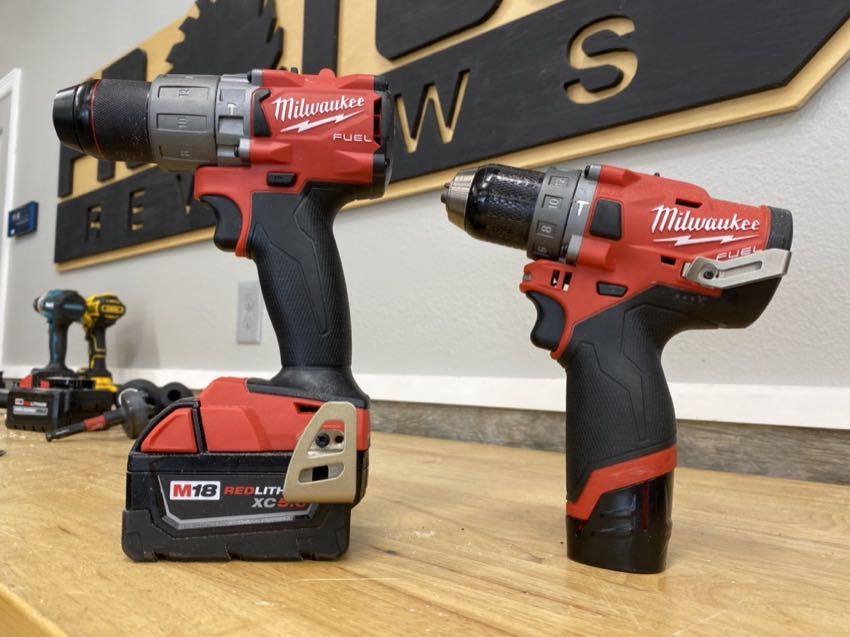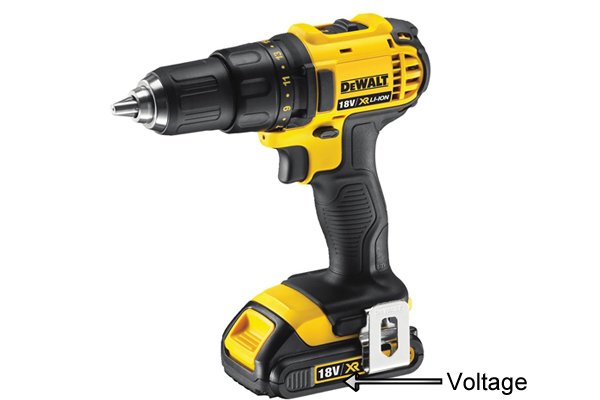If you’re wondering, “What voltage power drill do I need?” Look no further! Choosing the right power drill can be confusing, but I’m here to help. In this guide, we’ll break it down for you, making it easy to understand. So let’s dive in and find the perfect power drill for your needs!
Picture this: you’re working on a DIY project or fixing something around the house, and you need a power drill that gets the job done. But with so many options out there, how do you know which voltage power drill is right for you? Don’t worry, I’ve got your back. By the end of this article, you’ll have all the knowledge you need to make a confident decision.
Now, let’s clear up a common misconception. The voltage of a power drill doesn’t necessarily dictate its power or performance. It’s more about the battery life and the size of the projects you’ll be tackling. So, whether you’re a beginner or a seasoned DIY enthusiast, we’ll help you choose the perfect voltage power drill that suits your needs. Let’s get started!
Choosing the right voltage power drill is crucial for your DIY projects. Consider the following factors:
- Project Type: For light projects like hanging pictures, a 12V drill is sufficient. For heavier tasks like drilling through concrete, opt for 18V or higher.
- Battery Life: Evaluate the drill’s battery life to ensure it can handle your projects without needing frequent recharges.
- Torque: Higher voltages offer more torque, providing increased power for tough materials and drilling through thick surfaces.
- Portability: Lower voltage drills are usually lighter and more portable, making them suitable for on-the-go projects.
- Budget: Higher voltage drills tend to be more expensive. Consider your budget and the frequency of your projects.

The Right Voltage Power Drill: A Guide to Choosing the Perfect Tool
When it comes to power tools, one of the key decisions you’ll have to make is choosing the right voltage for your drill. The voltage of a power drill determines its power and capabilities, so it’s important to understand what voltage you need for your specific tasks. In this guide, we’ll explore the factors to consider when choosing a voltage power drill and provide helpful tips to ensure you make the right choice.
The Importance of Choosing the Right Voltage
1. Understanding Voltage: Voltage is the measurement of electrical potential energy between two points in a circuit. In the case of power drills, it determines the strength of the tool and its ability to handle different tasks. Higher voltage drills generally offer more power and are suitable for heavy-duty applications, while lower voltage drills are ideal for lighter tasks.
2. Consider Your Projects: The voltage you need depends on the types of projects you’ll be working on. If you’re a DIY enthusiast or a homeowner tackling small projects, a lower voltage drill (around 12 volts) should suffice. However, professionals and those working on larger projects may require a drill with a higher voltage, such as 18 volts or even 20 volts.
3. Battery Capacity: It’s essential to consider the battery capacity and runtime of a power drill when choosing the right voltage. Higher voltage drills often come with larger batteries, providing longer runtime, which is beneficial for extended or intensive projects. Lower voltage drills may have smaller, lightweight batteries, making them more suitable for shorter tasks or those requiring more maneuverability.
The Benefits of Low Voltage Power Drills
1. Lightweight and Portable: Low voltage power drills, such as those in the 12-volt range, are generally more compact and lightweight. This makes them easier to handle and maneuver, making them an excellent choice for overhead or intricate tasks.
2. Versatility: While low voltage drills may not have the power of their higher voltage counterparts, they can still handle a wide range of tasks. They are suitable for drilling holes in wood, plastic, and some light-duty metals. Additionally, they can drive screws and perform tasks like assembling furniture or hanging shelves.
3. Cost-Effective: Low voltage power drills are often more affordable compared to their higher voltage counterparts. This makes them a budget-friendly option for occasional or light-duty users who don’t need the power and versatility of a high voltage drill.
The Power of High Voltage Drills: Tackling Heavy-Duty Tasks
1. Increased Power and Speed: Higher voltage power drills, such as those in the 18-volt or 20-volt range, pack more punch. They offer increased drilling power and higher speeds, enabling them to handle tough materials like concrete, metal, and hardwood with ease.
2. Longer Battery Life: High voltage drills often come with larger battery capacities, allowing for longer runtime. This is particularly beneficial for professionals or individuals working on projects that require continuous drilling for extended periods.
3. Versatile Performance: High voltage drills are versatile tools that can handle a wide range of applications. They can drill larger holes, drive larger screws, and offer more torque for heavy-duty tasks. They are a go-to choice for construction professionals, contractors, or anyone working on demanding projects.
Considerations for Battery-Powered Drills
1. Battery Compatibility: When choosing a voltage power drill, it’s crucial to consider the battery compatibility within the same brand. Some manufacturers have interchangeable battery systems, allowing you to use one battery across multiple tools. This can save you money in the long run and make it more convenient to switch between tools.
2. Charging Time: Another factor to consider is the charging time of the batteries. Some drills come with fast-charging capabilities, allowing you to get back to work quickly. This is particularly useful if you have time-sensitive projects or need to work continuously for long periods.
3. Consider Future Needs: While it’s important to choose the right voltage for your current needs, it’s also wise to consider any potential future projects or advancements in your skillset. If you anticipate working on more substantial tasks or expanding your repertoire, investing in a higher voltage drill can be a wise long-term decision.
Choosing the Right Drill for You: A Summary
Choosing the right voltage power drill is crucial for ensuring optimal performance and efficiency in your projects. Consider the types of tasks you’ll be undertaking, the battery capacity and runtime you need, as well as any future plans or advancements. By weighing these factors, you’ll be able to make an informed decision that aligns with your needs and budget.
Key Takeaways: What Voltage Power Drill Do I Need?
- Consider the type of work you will be doing with the drill.
- For light household tasks, a 12V or 18V drill is sufficient.
- For more demanding projects, opt for a 20V or higher voltage drill.
- Bigger voltages offer more power and are suitable for heavy-duty jobs.
- Always check the manufacturer’s recommendations for the specific tool.
Frequently Asked Questions
When it comes to choosing the right voltage power drill, there are a few factors to consider. Let’s dive into some common questions people have when deciding what voltage power drill they need.
1. What are the different voltage options available for power drills?
Power drills are available in various voltage options, including 12V, 18V, and 20V. The voltage refers to the power output of the drill. Higher voltage usually means more power, allowing the drill to handle tougher tasks. However, higher voltage drills tend to be heavier and more expensive. So, it’s essential to choose a voltage that suits your needs and budget.
For lighter tasks like household repairs or DIY projects, a 12V or 18V power drill should be sufficient. If you frequently work on heavy-duty or professional projects, a 20V power drill may provide the necessary torque and strength.
2. How do I determine the voltage required for my specific projects?
When deciding on a voltage for your power drill, consider the type of projects you undertake. If you mainly work on small-scale tasks like assembling furniture or hanging shelves, a lower voltage drill should meet your needs. These tasks don’t typically require the power of a higher voltage drill.
If you often tackle larger projects that involve drilling into hard materials like masonry or steel, a higher voltage drill may be more suitable. In these cases, the extra power can make the drilling process more efficient and less strenuous. Assess the types of projects you typically take on and choose a voltage that aligns with those needs.
3. Are there any drawbacks to using a higher voltage power drill?
While higher voltage power drills offer more power, they do come with a few drawbacks. One of the main downsides is the increased weight. Higher voltage drills tend to be heavier due to their larger batteries and additional features to handle the extra power. This added weight can make the drill more tiring to use, especially during prolonged or overhead tasks.
Furthermore, higher voltage drills are generally pricier compared to lower voltage options. If you’re on a tight budget or only require a drill for occasional use, investing in a lower voltage option might be more economical. It’s important to find the right balance between power, usability, and cost when choosing a power drill.
4. Can I use different voltage batteries in a power drill?
In most cases, power drills are designed to be used with a specific voltage battery. Using a battery with a different voltage than recommended can cause damage to the drill and compromise its performance. It’s always best to use batteries that are compatible with the voltage specified by the manufacturer.
If you have multiple power tools from the same brand, it’s often possible to interchange batteries among them as long as they are of the same voltage. This can be convenient as it allows you to use the same batteries for different tools within your collection.
5. Should I consider other factors besides voltage when choosing a power drill?
Absolutely! While voltage is an important consideration, there are other factors to take into account as well. These include the drill’s chuck size, speed settings, ergonomics, and additional features like built-in LED lights or adjustable torque settings.
Consider how you will be using the drill and what features are important to you. For instance, if you frequently work in dimly lit areas, a drill with an LED light can be highly beneficial. If you need precise control over the speed and torque, look for a drill with multiple speed settings and adjustable clutch settings.
How To Choose A Cordless Drill or Impact Driver – Ace Hardware
Summary
So, to sum it up, choosing the right voltage power drill depends on what you’ll be using it for. If you’re just doing basic tasks around the house, a lower voltage drill, like 12 volts, will work just fine. But if you need more power for heavy-duty projects, like drilling into concrete, a higher voltage drill, like 18 volts or higher, will be better. It’s also important to consider the battery and weight of the drill, as these factors can affect your overall experience. So, think about your needs and choose wisely!
In conclusion, picking the right voltage power drill is about finding the balance between power and usefulness for your specific tasks. Don’t forget to consider the type of projects you’ll be doing, the battery life, and the weight of the drill. With these factors in mind, you’ll be well-equipped to make an informed decision and find the perfect power drill for your needs. Happy drilling!

